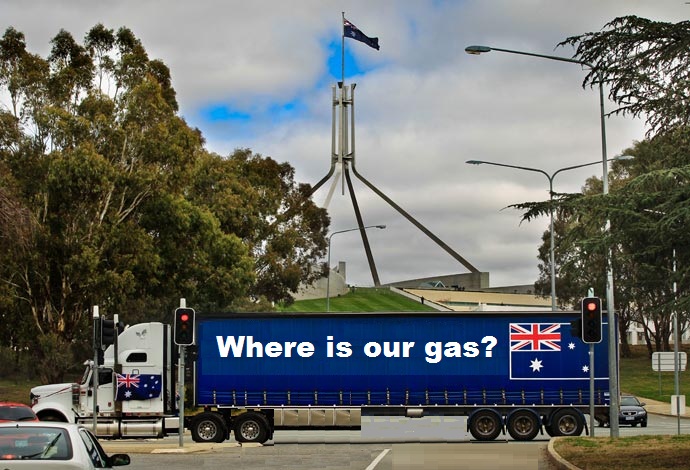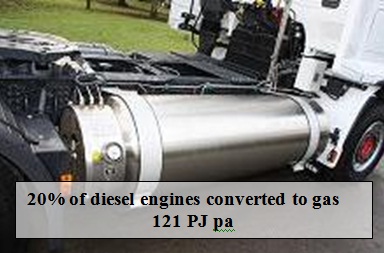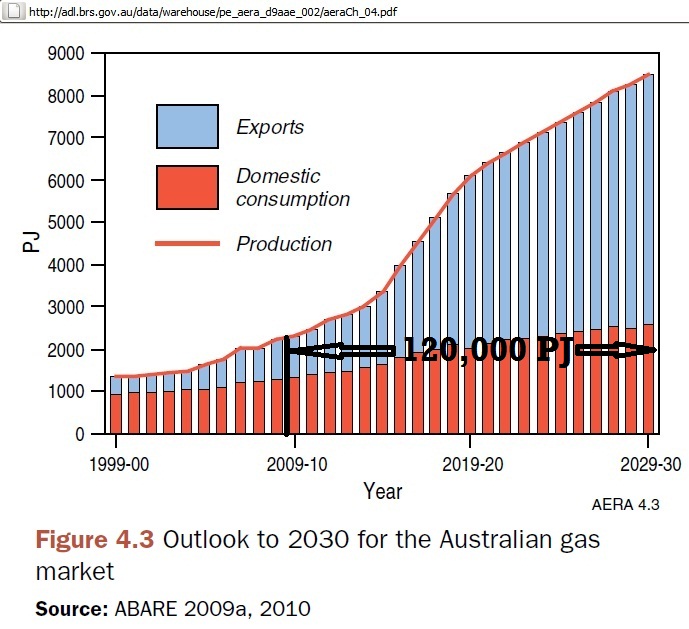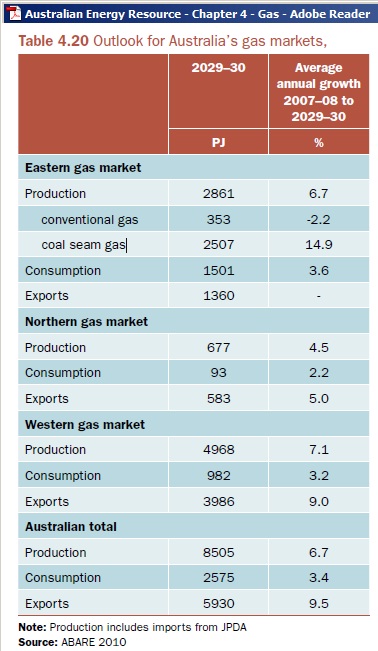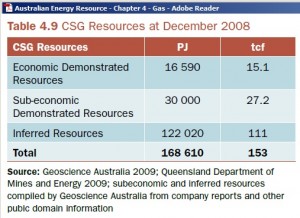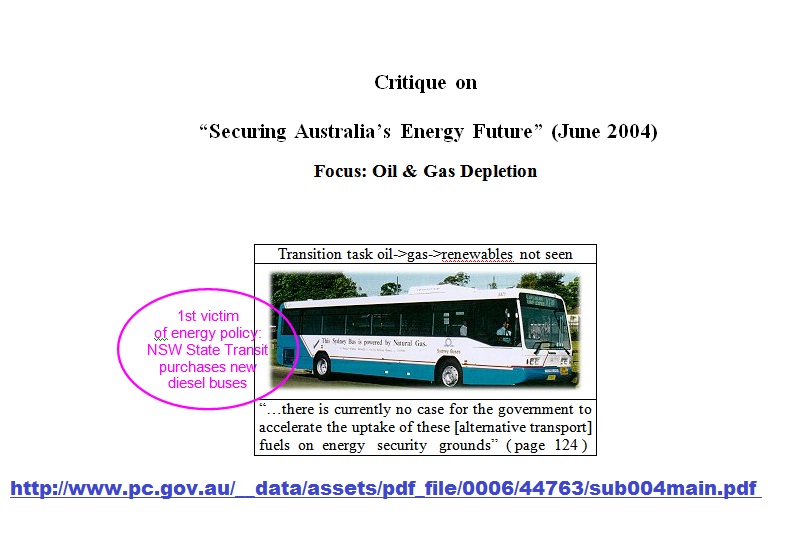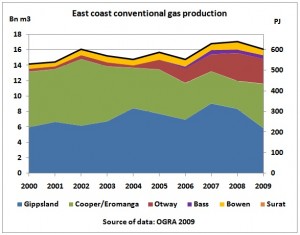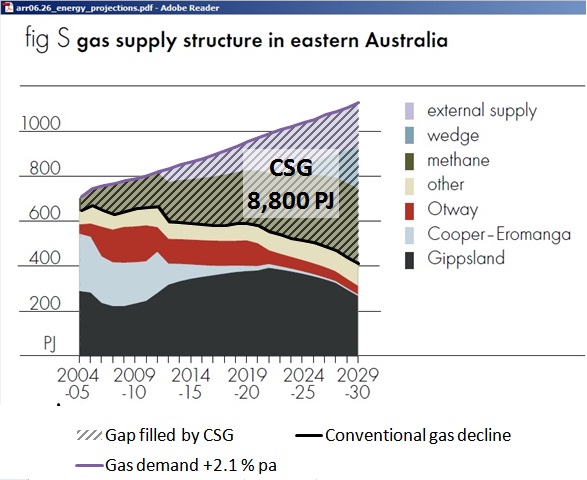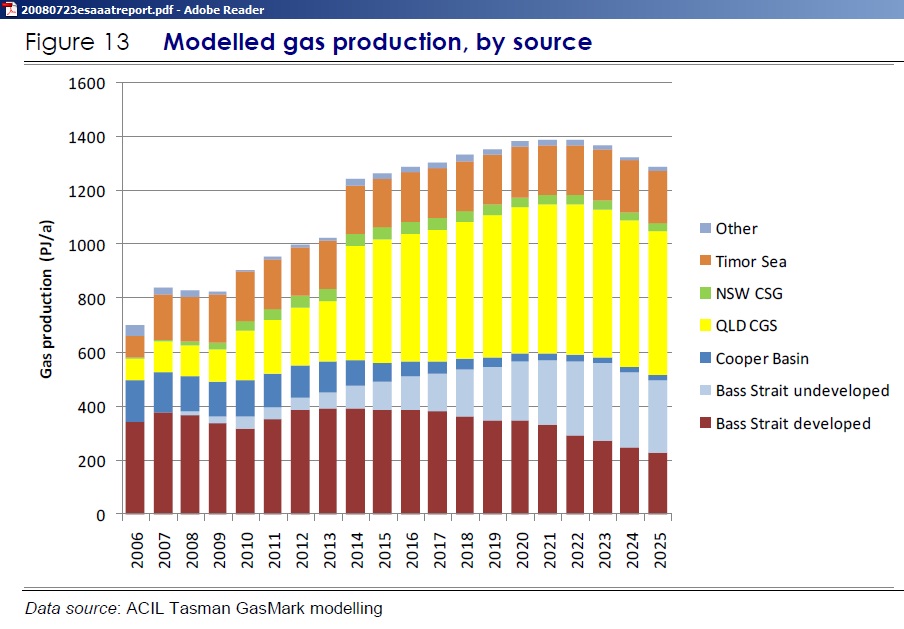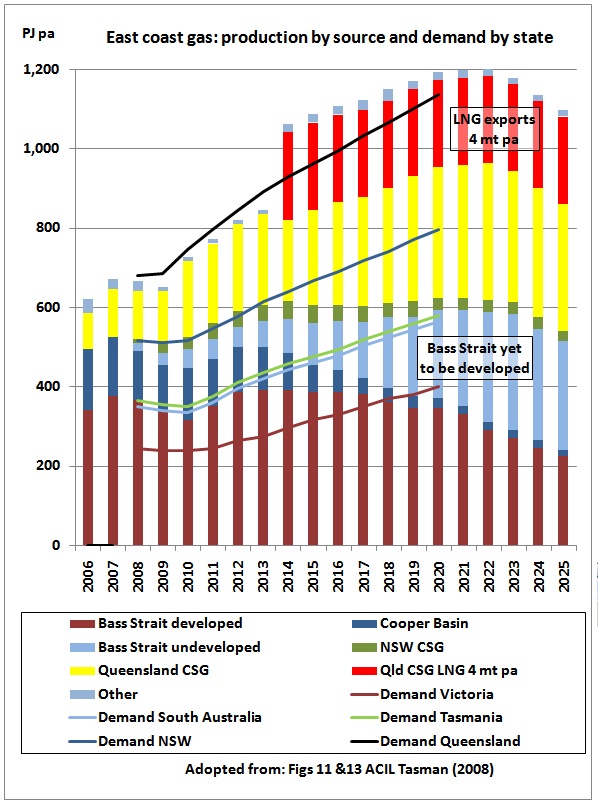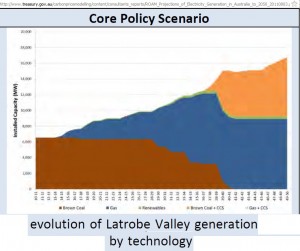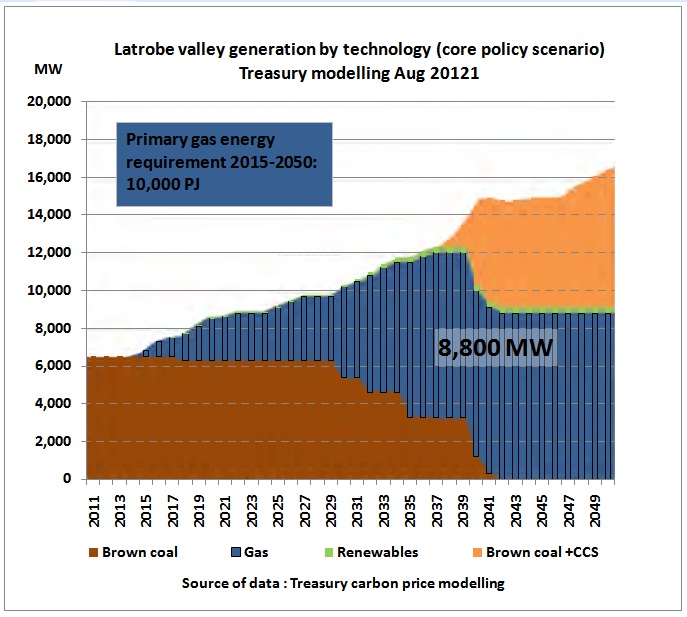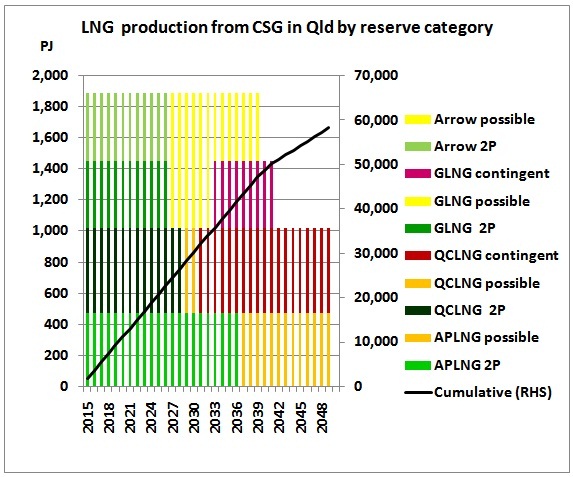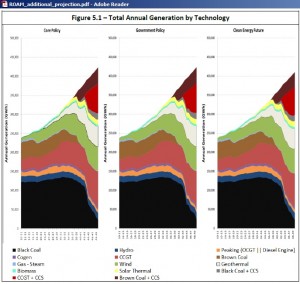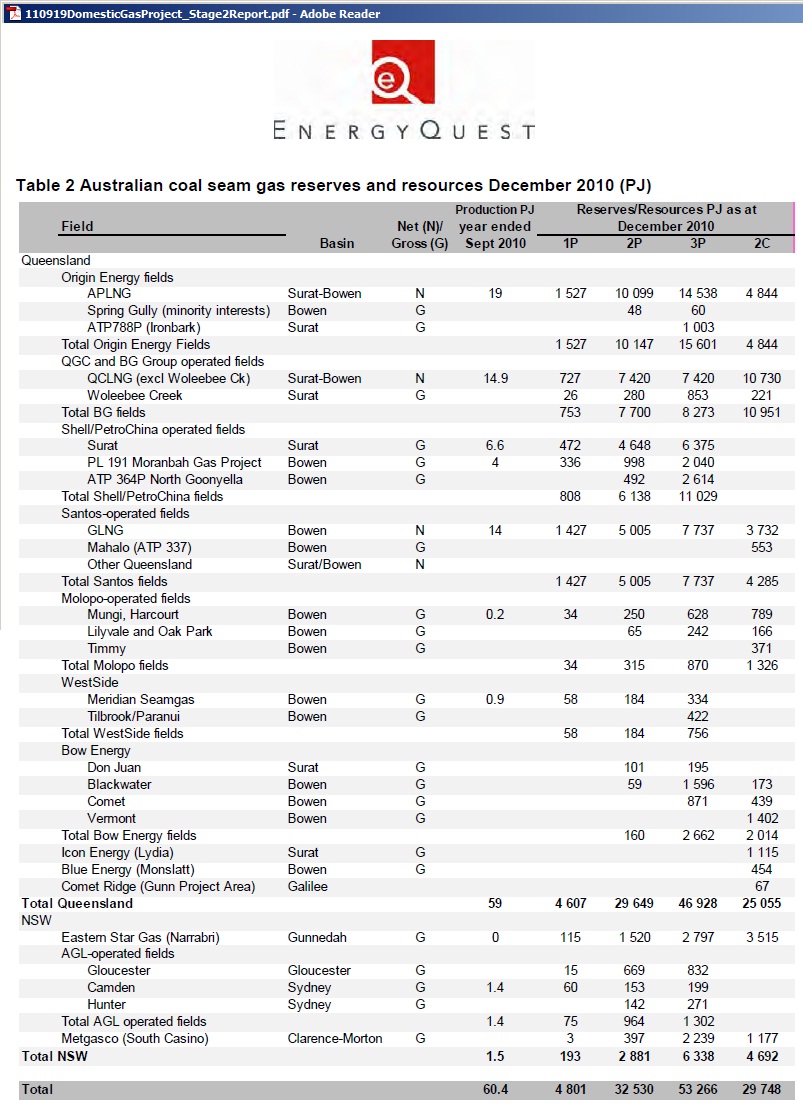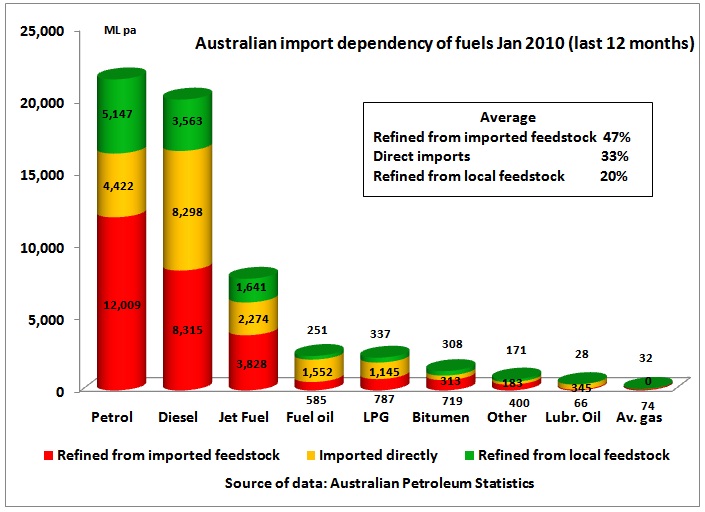East Coast Part 1
Oil crunch in year x: truck in a convoy of consequences for Canberra
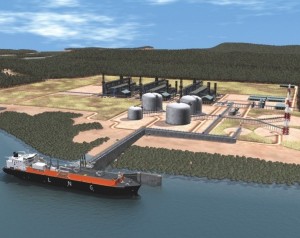 LNG export terminal in Gladstone
LNG export terminal in Gladstone
Going…..going……gone
Contents
(1) The national gas supply context
(2) Conventional gas decline on East coast
(3) Coal to gas transition, example Latrobe brown coal
(4) LNG exports from Queensland
(5) Adding it all up until 2050
(6) CSG reserves as at Dec 2010
(7) Balancing it
(8) Replacing declining oil production by gas
(8.1) Linear transition
(8.2) Oil decline until 2020
(8.3) Oil replacement requirement until 2020
————
The size of the images below correlates to the annual gas consumption
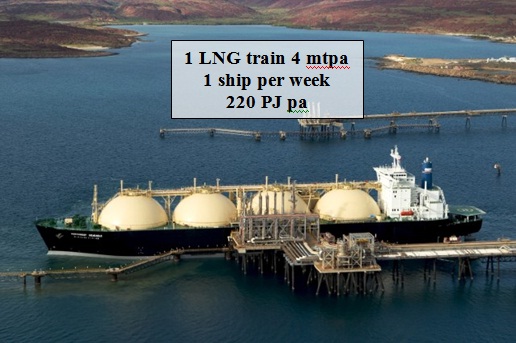 LNG exports will make Australia poor in alternative transport fuels
LNG exports will make Australia poor in alternative transport fuels
Summary:
(1) An East coast gas demand growth to 1,100 PJ pa in 2020 as projected by ACIL Tasman would already lead to gas shortages even before the first LNG is exported from Queensland
(2) No gas has been set aside for use as transport fuel to replace dwindling oil production and declining global net oil exports which will lead to a deep global oil crisis within this decade
No priorities have been set for the use of 2P gas reserves to
(a) replace oil
(b) replace coal
(3) The Federal Treasury’s carbon price modelling for replacing brown coal in the Latrobe valley power stations by natural gas over a period until 2050 uses coal seam gas which has already been committed in LNG exports from Gladstone
(4) The whole East coast gas demand has been over booked by 78% in relation to 3P reserves and furthermore rests on the untested assumption that speculative 2C resources can be developed economically in a period of economic and financial challenges
(5) The coal seam gas business in the context of the lack of international agreements to leave an energy equivalent amount of coal in the ground for good will INCREASE CO2 emissions.
(6) When the global oil crunch turns physical, we have to expect that oil markets will freeze (like credit markets). Oil trading will then morph into barter deals like oil for food, negotiated between companies and countries. Destination countries of Australia’s LNG exports have nothing to offer in terms of oil, they are oil importers themselves.
(7) Financial benefits for shareholders of companies investing in these LNG projects will be exported to countries where these shareholders reside so Australia’s net trade win will be (partially?) wiped out by overseas transfers. These financial gains by foreign investors will not be used to build up genuinely renewable energy systems which have to ultimately replace the gas exported. Not to mention that any profits can be lost on the share market within days
(8) Every LNG ship like every coal ship generates future compensation claims, in particular from Asian neighbours whose river deltas will be flooded and whose population will head for the North of Australia to look for new farming land.
Recommendations:
(a) Due to the interconnection of the East coast gas network the whole gas supply situation from Queensland to Victoria must be reviewed. It is already very late because many LNG projects in Queensland have already been approved and/or are under construction. This will have a negative impact on other States along the East coast
(b) It must first be assessed for which purposes how much gas is needed along the East coast over the projection period (until 2050). It is not sufficient to assume there will be gas demand growth of x percent. Requirements must be specifically listed and prioritised. Gas as transport fuel, in particular for buses and trucks needs to be set aside first. This would be equal to 5.5 LNG trains alone (for the whole of Australia). Next comes gas for generators who replace coal fired power plants. Then gas for utilities and residential use. At the end of the list should be exports.
(c) On the gas supply side a clear distinction should be made between most economic 2P (proven and probable), more expensive possible resources (giving a total of 3P) and speculative 2C resources. 2P reserves must be set aside for priority uses.
(d) Under no circumstances should more LNG projects be approved as the gas will be needed for local uses.
(e) The Sydney Metropolitan Strategy must be urgently reviewed because the Planning Department has done no energy requirement calculations (oil, gas, coal) for its growth plans, nor was the CO2 absorption capacity of the atmosphere for these fossil fuels assessed.
(f) Instead of an oil and gas export bonanza, resource nationalism and conservation must be promoted.
(1) National gas supply context
According to current plans, the equivalent of conventional gas reserves will be consumed in just 20 years. From the Australian Energy Resource Assessment chapter 4 on gas (West coast and East coast together, March 2010) we find this estimated production profile:
http://adl.brs.gov.au/data/warehouse/pe_aera_d9aae_002/aeraCh_04.pdf
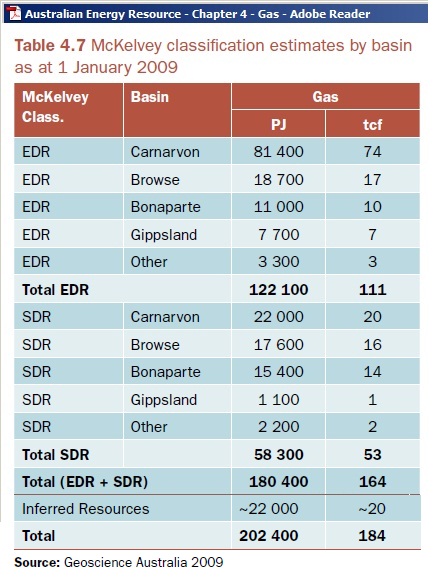 The total assumed to be produced between 2009 and 2030 is 120,000 PJ, 37% domestic consumption and 63% exported. This is approximately the equivalent of the total “Economic Demonstrated Resources” of conventional gas (Jan 2009) as can be seen from the table (left)
The total assumed to be produced between 2009 and 2030 is 120,000 PJ, 37% domestic consumption and 63% exported. This is approximately the equivalent of the total “Economic Demonstrated Resources” of conventional gas (Jan 2009) as can be seen from the table (left)
The gas resources are classified as EDR and SDR
Conventional gas
EDR= Economic Demonstrated Resources (2P = proved and probable)
SDR= Subeconomic Demonstrated Resources
Will the SDR ever be produced? Can the economy afford to pay higher prices for this gas?
The above production profile contains coal seam gas with an assumed production of 2,507 PJ pa in 2030, from following reserves:
Please note that CSG EDR and SDR have increased since this assessment (as quoted from Energy Quest in this article) but the total production and use of gas in comparison to EDR reserves is shockingly high. The public is being told gas reserves will last x hundred years at current production levels. But these production levels will be increased almost 10 fold. So the gas industry’s arguments are misleading just like the oil industry’s argument that oil supplies will last for 40 years.
It is an untested assumption that an economy damaged by peak oil is strong enough to finance the development of inferred gas resources for which no production cost estimates have been done.
So this fast exploitation makes us very suspicious. The objective seems to be to sell gas as fast as possible and ask questions later.
The peak oil ignorant Howard government boosted LNG exports in 2002 as described in the 2004 Energy White Paper
“…there is currently no case for the government to accelerate the uptake of these [alternative transport] fuels on energy security grounds” ( page 124 )
It was criticised in my submission #4 to the Productivity Commission
http://www.pc.gov.au/__data/assets/pdf_file/0006/44763/sub004main.pdf8/7/2011
“Yes, Prime Minister”, peak oil 2006 under your watch
http://crudeoilpeak.in-under-your-watchfo/yes-prime-minister-peak-oil-2006
(2) Conventional gas decline on East coast
East coast conventional gas production has been around 600 PJ pa for a number of years during the last decade.
http://www.ga.gov.au/products-services/publications/oil-gas-resources-australia/2009.html
According to Geoscience Austalia’s OGRA 2009 report (table above) the depletion level can be calculated at 67% (Cat 1 Reserves) and 56% (Cat 1+2 Reserves) respectively.
Conventional gas production from the East coast is fully booked for normal current and future demand.
Gas production and demand projections
(2.1) ABARE
Let us take ABARE report 06.26 (from December 2006) which assumes gas demand growing to 1,100 PJ pa (+2.1% pa) by 2030 while conventional gas supplies will decline from 600 PJ pa to 415 PJ pa in the same period.
http://adl.brs.gov.au/data/warehouse/pe_abare99001338/arr06.26_energy_projections.pdf
This report actually predicted that Eastern gas demand will outstrip supply in 2012/13 – see page 42
Note ABARE’s terms “wedge” and “external supply” which are used to engineer eternal supply growth. The conventional gas decline curve, the hatched CSG gas area with total amount of gas and the growth curve have been added to the original ABARE graph for clarity reasons.
The gap between conventional gas supplies and demand sums up to 8,800 PJ which is supposed to come from coal seam gas. For 2030-2050 let us assume that gas demand remains at 1,100 PJ pa and conventional gas is petering out by 2050 so we’ll need another
1,100 * 20 – 415 * 20 * 0.5 = 17,850 PJ
Subtotal (2.1) CSG requirement offsetting conventional decline 26,650 PJ until 2050
(2.2) ACIL Tasman
ACIL Tasman did a projection of East coast gas production in 2008 which can be found in a report entitled
The impact of an ETS on the energy supply industry
The following graphs are from this report. They contain coal seam gas from Queensland and New South Wales:
In the same report we find a gas demand graph
We superimpose the production graph (stacked columns, excluding Timor sea as this is not on the East coast) and the demand graph (stacked curves)
Please note that the demand curves are stacked in the order of Southern states to Northern states (because the conventional gas is in the South which is also in the lower part of the graph) and that the Queensland curve is equivalent to the total East coast demand.
We can clearly see:
(1) Conventional gas production from existing fields in Bass Strait and Cooper basin are in decline
(2) Offsetting this decline will depend on the success of developing new fields in Bass Strait
(3) The stacked, increasing demand curves from the Eastern states are slightly above production and enter into the area of LNG export capacities of the 1st 4 mt train in Queensland
(4) A demand of 1,100 PJ is reached already in 2020, 10 years earlier than in ABARE’s projection.
(5) This explains the frantic efforts in Queensland and NSW to get at more coal seam gas.
(3) CSG gas use in Treasury’s carbon price modelling
The Treasury website on carbon price modelling
http://www.treasury.gov.au/carbonpricemodelling/content/consultantreports.asp
has this report from Roam Consulting dated 3/8/2011
Projections of Electricity Generation in Australia to 2050
http://www.treasury.gov.au/carbonpricemodelling/content/consultants_reports/ROAM_Projections_of_Electricity_Generation_in_Australia_to_2050_20110803.pdf
It contains a graph on phasing out brown coal in the Latrobe valley under the “core policy scenario” by using various technologies:
Conventional use of brown coal in existing power plants is phased out and replaced by natural gas over the next 30 years. In the last 10 years of the projection period carbon capture and storage is assumed to be commercially viable, using again brown coal. When digitising the graph in a spreadsheet
one finds that the gas plant capacity would have to reach 8,800 MW by the mid 2030s in order to allow a growth in electricity consumption of 2.5%
Gas requirements Latrobe valley
These Latrobe valley brown coal power plants are base load plants. Let us assume they run 80% of the time so each 1,000 MW would produce 1,000 MW * 0.8 * 365 * 24 h = 7,000 GWh
Using 1 KWh = 3.6 MJ this would be 25.2 PJ pa
Taking an efficiency factor of 50% (some coal plants are running at 35% now) that would be a primary energy requirement of 50 PJ pa of gas for each 1,000 MW.
The total requirement would therefore be 8.8 * 50 = 440 PJ pa in 2037. The total gas requirement until 2050 would be roughly:
Subtotal (3) CSG requirements Latrobe valley 10,000 PJ until 2050
(4) LNG exports from Queensland
We have following LNG projects in Qld with around 1,900 PJ pa. (schematic, without detailed phasing)
For comparison and to understand the magnitude of this exported energy, replacing Australia’s 33,000 ML of diesel and petrol consumed in 2009 – a quasi recession year – a minimum of 1,200 PJ pa would be needed.
The cumulative production in the above graph is:
2P reserves: 28,500 PJ
3P: 44,000 PJ
2C: 14,300 PJ
Subtotal (4) CSG requirements for LNG exports in Qld 3P plus 2C 58,300 PJ until 2050
(5) Adding it all up until 2050
Treasury’s Latrobe valley transition to gas: 10,000 PJ
Conventional gas decline offset and domestic growth: 26,650 PJ
4 LNG projects at Gladstone 58,300 PJ
Grand total ………………………………………………………. 94,800 PJ
As we shall see under (6) this gas has been overbooked.
These are primary energy transition graphs in Roam’s additional projections:
It should be noted that more gas than just that for the Latrobe valley will be required.
It goes beyond the scope of this article to evaluate these graphs for underlying gas requirements but it should be clear from the following calculations that gas has been overbooked already on the basis of the Latrobe valley transition.
(6) CSG reserves as at Dec 2010
CSG reserves as at Dec 2010 are taken from Energy Quest’s website
http://www.esaa.com.au/content/detail/2011_ReportsandPublications_esaa_domestic_gas_study
The total of 3P and 2C is 83,014 PJ
(7) Balancing it
So from (5) we have a total gas demand until 2050 of 94,800 PJ which exceeds
East coast 2P reserves of 32,530 PJ by 190%
East coast 3P reserves of 53,266 PJ by 78%
East coast 3P + 2C resources of 83,014 PJ by 14%
This means project participants and government bureaucracies are working on a set of numerous untested assumptions, namely that 3P and later 2C resources can be turned into 2P reserves,
- at the right price and at the right speed by drilling 1,000s of wells pa.
- fighting all land holders who are against it
- finding finance during the evolving debt crisis – which will NOT go away
It needs to be understood that the cost of producing gas is increasing as gas is produced. The following graph shows how offshore production costs in Victoria almost triple as reserves are being developed and produced:
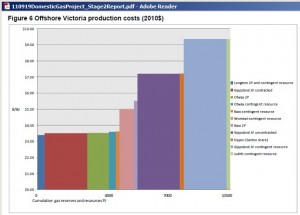 http://www.esaa.com.au/Library/PageContentFiles/73077044-5eae-407b-99bc-da94a789349d/110919DomesticGasProject_Stage2Report.pdf (March 2011, page 24)
http://www.esaa.com.au/Library/PageContentFiles/73077044-5eae-407b-99bc-da94a789349d/110919DomesticGasProject_Stage2Report.pdf (March 2011, page 24)
This will be similar with non-conventional gas. It is to be expected that the gas industry will develop, produce and export the easy and cheap coal seam gas 2P reserves first (80% of 2P reserves for LNG is already consumed by 2026) and then proceed to the more expensive 3P and 2C resources. This means that when the gas industry will be called upon to supply gas for the domestic market, eg. for an oil to gas transition as calculated in chapter 2 there will be a big and bad surprise.
Calculation up to 2035 (=end of 1st 20 years of LNG exports), roughly
Latrobe gas conversion 3,560 PJ
Offset conventional gas decline 12,300 PJ
4 LNG projects 39,700 PJ
Total 55,560 PJ also exceeding current 2P reserves
(8) Replacing declining oil production by gas as transport fuel
The points covered above deal with what can be found in the documentation referenced above. But what is being forgotten is that there is a need to replace declining oil production both domestically and globally by using gas as a transport fuel.
We have currently 1,200 PJ of petrol and diesel on the East coast to be replaced by gas.
The data for the above graphs are from the Australian Petroleum Statistics
http://www.ret.gov.au/resources/fuels/aps/pages/default.aspx
We need to consider the speed of the transition from oil to gas
(8.1) Linear transition
Most models assume a smooth and peaceful transition, e.g:
CSIRO: Road transport sector modelling (July 2011)
Therefore, let us assume linearly over 40 years (up to the end of Treasury’s projection period) a transition away from oil.
40 years * 0.5 * 1,200 PJ pa = 24,000 PJ
Such a linear transition would already require 300 PJ pa by 2020. The total transition to 1,200 PJ pa is the equivalent of 5.5 LNG export trains.
This simple calculation does not include any growth in demand for petrol and gas so this would be on the low side.
It could also be higher because 1 PJ of gas may yield less vehicle kilometres travelled (VKT) or ton km of freight as 1 PJ of petrol or diesel would achieve.
(8.2) Decline of available net crude oil exports
In this article
6/10/2011 Net crude oil exports – the shrinking commodity
http://crudeoilpeak.info/net-crude-oil-exports-the-shrinking-commodity
it was shown that available net crude oil exports could decline by 30% over 10 years to 2020
(8.3) Oil replacement requirement until 2020
Australia’s oil import dependency is 80%.
So for the whole of Australia we would need to replace until 2020
Petrol: 0.3 * 16,400 ML = 4,920 ML = 172 PJ pa (@ 35 MJ / litre)
Diesel: 0.3 * 16,600 ML = 4,980 ML = 181 PJ pa (@ 36.4 MJ / litre)
Annualy 353 PJ pa, this is the equivalent of 1.6 LNG trains (1 train = 4 mt pa or 220 PJ pa)
For the East coast this would be 80% of 353 PJ pa, 282 PJ pa by 2020
The whole infrastructure needs to be built up for this gas: additional pipelines to capital cities and regional centres, pumping stations, gas depots, CNG and LNG filling stations, the conversion of trucks and cars, training of gas mechanics etc. When will all this be done? Under current policies, or lack thereof, NOTHING will be done until physical petrol and diesel shortages arrive at the filling stations. The damage to the economy will be astronomical.
